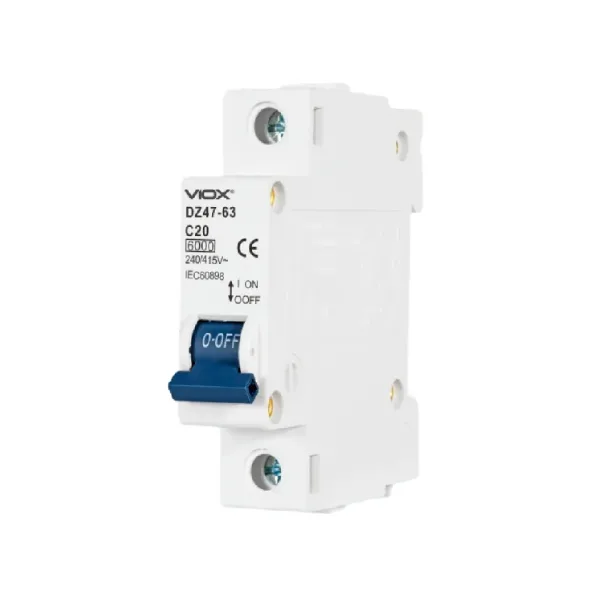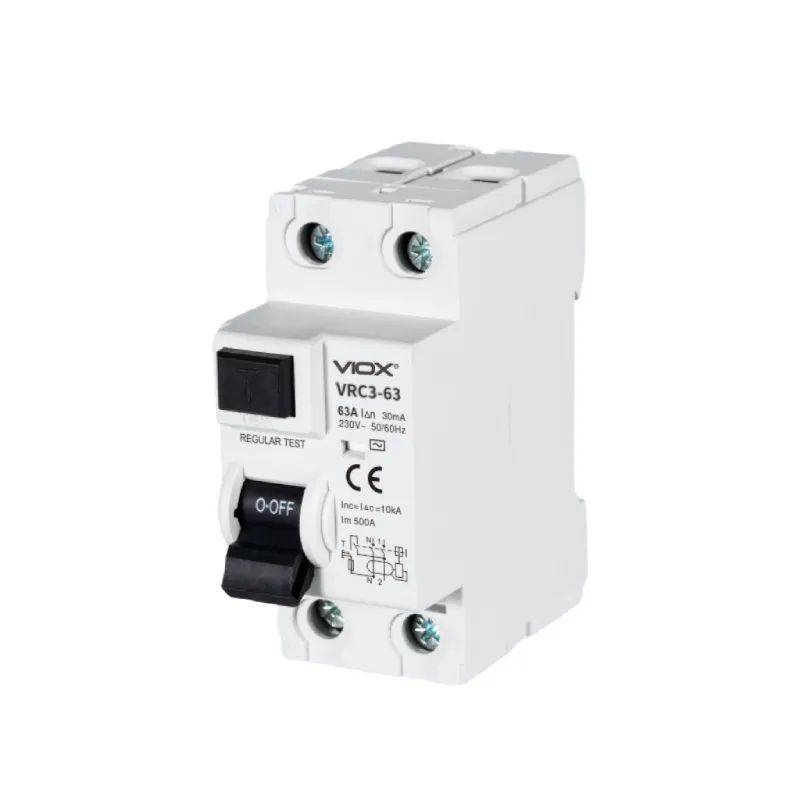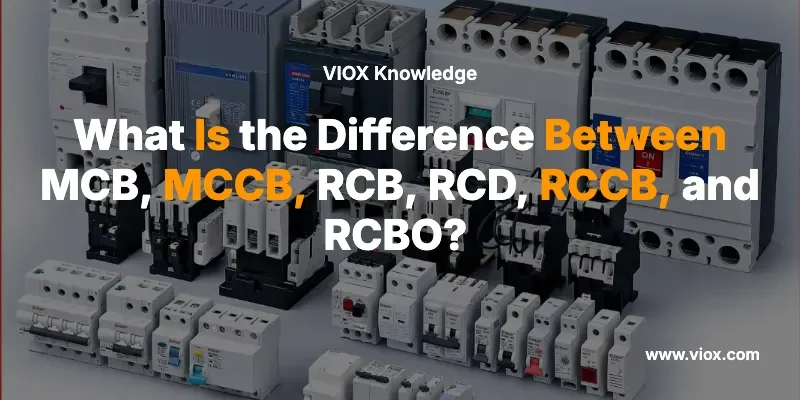TL;DR: MCB and MCCB protect against overloads/short circuits (low vs high current), while RCD, RCCB, and RCB protect against electrical leakage and shock. RCBO combines both protections in one device. Understanding these differences ensures proper electrical safety for your home or business.
Understanding Circuit Breaker Types: The Foundation of Electrical Safety
Circuit breakers serve as critical safety devices in every electrical installation, automatically interrupting power flow when dangerous conditions occur. These fixtures act as the third party within sophisticated and dangerous electrical wiring systems, protecting both equipment and human lives from electrical hazards.
The six main types—MCB, MCCB, RCB, RCD, RCCB, and RCBO—each serve specific protection functions, and selecting the wrong type can compromise your electrical system’s safety and efficiency.
MCB (Miniature Circuit Breaker): Your Home’s First Line of Defense
What Is an MCB?

MCB stands for Miniature Circuit Breakers. The MCB is an electromechanical device that switches off the circuit automatically if an abnormality is detected. These compact devices are designed specifically for low-voltage applications in residential and small commercial settings.
Key MCB Characteristics:
- Current Rating: 0.5A to 125A
- Voltage Rating: Up to 415V AC
- Protection Type: Overload and short circuit
- Trip Curves: B, C, D, and Z types for different applications
- Poles: Single, double, triple, and four-pole options
MCB Applications:
MCBs excel in protecting:
- Lighting circuits
- Power outlets
- Small appliances
- Residential distribution boards
- Commercial circuits under 125A
Pro Tip: B and C curves work well for typical loads, but D and Z curves are better for high inrush currents like motors or sensitive equipment.
MCCB (Molded Case Circuit Breaker): Heavy-Duty Protection
What Is an MCCB?

Molded Case Circuit Breakers are the industrial-grade solution for higher current applications. MCCBs are used for high currents up to 1000 amps, making them essential for commercial and industrial installations.
Key MCCB Characteristics:
- Current Rating: 100A to 2,500A
- Voltage Rating: Up to 1,000V AC
- Breaking Capacity: Up to 200kA
- Adjustable Settings: Trip curves and time delays
- Remote Operation: Available via shunt trip mechanisms
MCCB vs MCB: Critical Differences
| Feature | MCB | MCCB |
|---|---|---|
| Current Range | 0.5A – 125A | 100A – 2,500A |
| Applications | Residential/Small Commercial | Industrial/Large Commercial |
| Adjustability | Fixed settings | Adjustable trip settings |
| Size | Compact | Larger footprint |
| Cost | Lower | Higher |
| Remote Control | Not available | Available |
When to Choose MCCB:
- Motor control centers
- Industrial distribution panels
- Large HVAC systems
- Power distribution to multiple buildings
- Applications requiring adjustable protection settings
RCD/RCCB (Residual Current Device/Residual Current Circuit Breaker): Life-Saving Protection
Understanding RCD and RCCB

RCCB stands for Residual Current Circuit Breaker. RCCB is also known as RCB or RCD. RCD stands for Residual Current Device, while RCB stands for Residual Current Breaker. These terms are often used interchangeably, referring to the same protective function.
How RCDs/RCCBs Work:
RCCB is an electrical wiring device that disconnects the circuit as soon as it detects a current leak to the earth wire. It also protects against electric electrocution or shock caused by direct contact.
The device monitors current flow between live and neutral conductors. In a healthy circuit, these currents are equal. When leakage occurs (such as through a person or damaged equipment), the imbalance triggers immediate disconnection.
Key RCD/RCCB Specifications:
- Sensitivity Ratings: 10mA, 30mA, 100mA, 300mA
- Response Time: Typically 30 milliseconds
- Pole Configuration: 2-pole and 4-pole options
- Current Rating: 25A to 125A
Critical Applications:
- Bathroom and kitchen circuits
- Outdoor electrical installations
- Pool and spa equipment
- Medical equipment areas
- Workshop power tools
Important Note: RCCBs do not have a short-circuit withstand rating because they do not protect against short circuits. It is strongly advised to connect a short circuit protection device such as an MCB or MCCB in series with the RCCB.
RCBO (Residual Current Breaker with Overcurrent Protection): The Ultimate Solution
What Makes RCBO Special?

RCBOs are essentially a combination of MCB and RCCB. As such, it can protect overload and short circuits. This dual functionality makes RCBOs the most comprehensive single-device protection solution available.
RCBO Capabilities:
Overcurrent Protection (like MCB):
- Overload protection via thermal mechanism
- Short circuit protection via magnetic mechanism
- Current ratings from 6A to 63A
Residual Current Protection (like RCCB):
- Earth leakage detection
- Electric shock prevention
- Sensitivity options: 10mA, 30mA, 100mA, 300mA
RCBO Advantages:
- Space Efficiency: Single device replaces MCB + RCCB combination
- Cost Effective: Reduces overall installation costs
- Simplified Wiring: Fewer connections mean reduced installation time
- Enhanced Safety: Comprehensive protection in one unit
Ideal RCBO Applications:
- New residential installations
- Retrofit upgrades
- Critical circuits requiring both protections
- Space-constrained panels
- High-value equipment protection
Comprehensive Comparison Table
| Device | Primary Protection | Secondary Protection | Current Range | Typical Applications |
|---|---|---|---|---|
| MCB | Overload/Short Circuit | None | 0.5A – 125A | Residential circuits |
| MCCB | Overload/Short Circuit | None | 100A – 2,500A | Industrial systems |
| RCD/RCCB | Earth Leakage | None | 25A – 125A | Shock protection |
| RCBO | Overload/Short Circuit | Earth Leakage | 6A – 63A | Complete protection |
Selection Guidelines: Choosing the Right Protection
For Residential Applications:
- Kitchen Circuits: RCBO (30mA) – Combined protection against overload and shock
- Bathroom Circuits: RCBO (30mA) – Essential for wet locations
- Lighting Circuits: MCB (Type B) – Basic overload protection sufficient
- General Power Outlets: RCBO (30mA) – Comprehensive safety
For Commercial Applications:
- Office Areas: MCB + RCCB combination or RCBO
- Workshop Areas: RCBO (30mA) for power tools
- HVAC Systems: MCCB with appropriate current rating
- Outdoor Lighting: RCBO (30mA) for weather protection
For Industrial Applications:
- Motor Control: MCCB with motor protection curves
- Distribution Boards: MCCB as main protection
- Critical Equipment: RCBO where both protections needed
- Control Circuits: MCB for basic protection
Common Installation Mistakes to Avoid
Improper Device Selection:
- ❌ Using MCB for high-current applications – Can lead to nuisance tripping or inadequate protection
- ❌ Installing RCCB without MCB backup – Leaves circuits vulnerable to short circuit damage
- ❌ Wrong sensitivity rating for RCD/RCBO – 10mA for medical areas, 30mA for general use, 100mA+ for supply circuits
Installation Errors:
- ❌ Incorrect wiring of RCD/RCBO – All circuit conductors must pass through the device
- ❌ Mixing neutral conductors – Each RCD/RCBO requires dedicated neutral connection
- ❌ Ignoring environmental factors – Use appropriate IP ratings for harsh conditions
Testing and Maintenance Best Practices
Monthly Testing Requirements:
RCD/RCCB/RCBO Test Button:
- Press the test button monthly
- Device should trip immediately
- Reset and verify normal operation
- If device fails to trip, call a qualified electrician immediately
Annual Professional Inspection:
- Verify proper operation under load
- Check connection tightness
- Measure insulation resistance
- Test trip times and sensitivity
- Inspect for physical damage or overheating signs
Future-Proofing Your Electrical Installation
Smart Circuit Breakers:
Modern installations increasingly incorporate smart breakers with:
- Remote monitoring capabilities
- Real-time current measurement
- Predictive maintenance alerts
- Integration with home automation systems
Arc Fault Detection:
AFCIs detect arc faults, which are tiny sparks that can start fires. These breakers are now required in many areas of the home, especially bedrooms and living spaces.
Consider AFCI protection for:
- Bedroom circuits
- Living room outlets
- Home office areas
- Any location with extension cord use
Regulatory Compliance and Standards
Key Standards to Follow:
- IEC 60898: Miniature circuit breakers for household use
- IEC 60947-2: Molded case circuit breakers
- IEC 61009: RCBOs for household applications
- IEC 62423: Type A and Type AC RCDs
Regional Requirements:
- United States: NEC Article 210 requirements for AFCI and GFCI protection
- Europe: Installation standards per IEC 60364
- Australia: AS/NZS 3000 wiring rules
Always consult local electrical codes and engage qualified electricians for installation and major modifications.
Cost Analysis and ROI
Initial Investment Comparison:
| Solution | Equipment Cost | Installation Cost | Total Cost |
|---|---|---|---|
| MCB + RCCB | Medium | Higher | Higher |
| RCBO | Higher | Lower | Medium |
| Smart RCBO | Highest | Lower | Higher |
Long-term Benefits:
Safety ROI:
- Prevention of electrical fires (average cost: $13,000+)
- Protection against electrocution injuries
- Reduced insurance premiums
Operational ROI:
- Reduced downtime from electrical faults
- Lower maintenance costs
- Enhanced equipment lifespan
Conclusion: Making the Right Choice
Understanding the differences between MCB, MCCB, RCB, RCD, RCCB, and RCBO is crucial for electrical system safety and efficiency. Here’s your decision framework:
Choose MCB when: You need basic overload/short circuit protection for residential circuits under 125A
Choose MCCB when: You’re dealing with industrial applications requiring high current ratings (100A+) and adjustable settings
Choose RCD/RCCB when: Earth leakage protection is the primary concern, used with separate MCB for overload protection
Choose RCBO when: You want comprehensive protection (overload + earth leakage) in a single, space-efficient device
Remember, electrical safety is not negotiable. When in doubt, consult with a qualified electrician who can assess your specific requirements and ensure compliance with local codes and standards.
The investment in proper circuit protection pays dividends in safety, equipment protection, and peace of mind. Choose wisely, install correctly, and maintain regularly for optimal electrical system performance.
Related
Difference Between Molded Case Circuit Breakers and Standard Circuit Breakers
What is the Difference Between RCCB and ELCB?
RCCB Full Form: Understanding Residual Current Circuit Breakers


